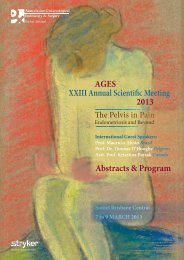to Obstetric Trauma Pelvic Floor Repair Surgical Essentials - AGES
to Obstetric Trauma Pelvic Floor Repair Surgical Essentials - AGES
to Obstetric Trauma Pelvic Floor Repair Surgical Essentials - AGES
You also want an ePaper? Increase the reach of your titles
YUMPU automatically turns print PDFs into web optimized ePapers that Google loves.
<strong>AGES</strong><br />
<strong>Pelvic</strong> <strong>Floor</strong><br />
Symposium &<br />
Workshop XII<br />
2011<br />
<strong>to</strong><br />
<strong>Obstetric</strong> <strong>Trauma</strong><br />
<strong>Pelvic</strong> <strong>Floor</strong> <strong>Repair</strong><br />
<strong>Surgical</strong> <strong>Essentials</strong><br />
There are some case reports confirming that the TVT remains intact<br />
during pregnancy and after delivery on ultrasound assessment.<br />
What is the most optimal way <strong>to</strong> deliver after a preceding midurethral<br />
sling procedure<br />
If no stress incontinence develops during pregnancy, it is quite<br />
difficult <strong>to</strong> advise about mode of delivery.<br />
If nulliparous, arguments for elective caesarean delivery include<br />
vaginal delivery contributes significantly more <strong>to</strong> the development of<br />
SUI than a caesarean section. On the basis of the Epincont Study,<br />
the risk of SUI after a vaginal delivery is 2.4 times higher compared<br />
<strong>to</strong> a caesarean section. Postpartum continence rates after preceding<br />
bladder neck suspension are 73% after vaginal delivery and 92%<br />
after caesarean section. The argument against an elective caesarean<br />
delivery is that this represents major surgery with considerable impact<br />
on future pregnancies eg. risk of uterine rupture.<br />
If multiparous, the discussion is more difficult, as subsequent<br />
pregnancies contribute less <strong>to</strong> the development of SUI than the first<br />
pregnancy and delivery.<br />
In cases where SUI develops during pregnancy after preceding<br />
incontinence surgery, there is a tendency in literature not <strong>to</strong> advise an<br />
elective caesarean delivery. The natural course of SUI after pregnancy<br />
indicates that SUI resolves in a significant percentage. A midurethral<br />
sling is a minimally invasive procedure compared <strong>to</strong> an elective<br />
caesarean delivery. A second midurethral sling is likely <strong>to</strong> be as effective<br />
as the first one . One reason for an elective caesarean delivery might be<br />
that increased damage <strong>to</strong> the urethral sphincter due <strong>to</strong> a vaginal delivery<br />
can be prevented. However, there is no evidence <strong>to</strong> support this.<br />
Approach may be; Try <strong>to</strong> complete childbearing before any<br />
incontinence surgery.<br />
If a woman is pregnant after mid-urethral sling surgery, institute<br />
conservative treatment during pregnancy. Advise vaginal delivery in an<br />
otherwise uncomplicated pregnancy irrespective of recurrent incontinence.<br />
If incontinence occurs or persists postpartum, await spontaneous<br />
recovery for at least 6 months up <strong>to</strong> one year.<br />
Repeated mid-urethral sling procedure, if necessary, is most likely<br />
safe and effective (not enough data).<br />
REFERENCE:<br />
Int Urogynecol J (2008) 19:441–448<br />
10<br />
AUTHOR AFFILIATION: Dr Anna Rosamilia; Urogynaecology and<br />
<strong>Pelvic</strong> Reconstructive Surgery, Cabrini Medical Centre, Malvern,<br />
Vic<strong>to</strong>ria, Australia.

















